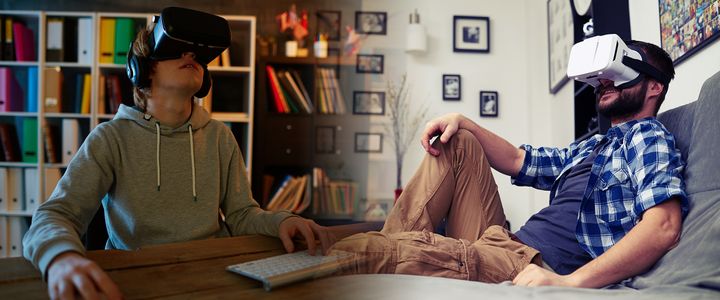
I wanted to share this insightful article written by my Dubit colleague, Sean Thompson. It appeared originally on Dubit’s blog.
With growing consumer ownership of VR headsets — the rapid spread of Google Cardboard, the launches of Oculus Rift and HTC Vive, the anticipated debuts of Google Daydream and PlayStation VR, and more — content creators are eager to adapt their IP for this immersive medium. There are great games and experiences already out there (check out our WEARVR and Bogglebox aggregators for general audience and kid-specific apps), but also some challenges.
For example, how do you build social into virtual reality? Thus far, most experiences are solo and disembodied, and few devices are built for talking with or reaching out to others. There have been speculative demos, like this one from Facebook (owner of Oculus), and a few social games are on the market, in full or in beta.
The first virtual reality game with any social element I played was Karts Sprint on Gear VR. It’s a multiplayer game, but that’s not the social element I’m referring to. When you’re in the lobby, before the racing starts, you can look around, and your avatar’s helmet will match the orientation of your own. That allows you to nod, shake and tilt your head. While you can’t see your own gestures, you can see everyone else’s, and they can see you.
The result is up to eight people in virtual space, looking around and nodding at each other. Even with no words or facial expressions, it’s surprisingly obvious whether people are sending you positive or negative messages. The precisely-reproduced movement is very human, and that encourages users to want to communicate with each other.
Oculus Social (Beta), by contrast, is an overtly social app that just doesn’t work as well. Multiple people can watch Twitch and Vimeo videos with other people, ‘sitting on a sofa’ as disembodied heads that move in a similar way to Kart’s helmets. Maybe it’s because the core experience of VR cinema is still a bit of a novelty (never done correctly, and at a time before the hardware is up to reproducing an authentic experience), or maybe it’s the feeling that disembodied heads in a real-world situation should elicit deeper interactivity, or perhaps it’s knowing the blinking eyes are just an animation.
The Karts Sprint game has a brilliant setup for the level of communication the Gear VR allows — only the tilt sensors on the headset react to natural movement. It doesn’t matter that it doesn’t detect eye or mouth movements, because the helmet covers these in-world. It doesn’t track body movement, but sitting in a Kart with your hands on the wheel and feet on the pedals gives them a job which fits the narrative.
These are two great examples of the need to align game features at the intersection of device affordances and human behavior patterns. A true social experience requires that people communicate with each other. That can be as simple as a nod or shake, but has to mean more than simply several people inhabiting and influencing a single environment at once.
What does your hardware support for conveying information? How would you best use the various input features in ways that are natural to the user (tile sensors, movement tracking, audio input, real blinks)?
Don’t attempt to ‘fill in the blanks’ with your own animations and sounds, or you’ll get the robotic blinking effect of Oculus Social; instead, just accept and accommodate the blanks in-world. Soon enough, there will be instinctive uses for buttons, joysticks, keyboards and the like, but even these won’t work for all audiences (especially the very young).
These are the kinds of design issues that Dubit encounters in its growing practice producing virtual reality games and experiences. Because we focus on children and youth — still an uncertain audience for VR — we’re also conducting extensive research into “best practices” with physicians, psychologists, academics, and kids.
Do you have a thorny design issue — in VR, or in app, game or content on demand design? Get in touch with our VP of Digital at bobby.thandi@dubitlimited.com.